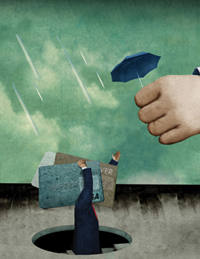Banks Had Free Rein to Set Credit Card Rules, Now Congress is Looking to Restack Deck

Illustrations by Michael Morgenstern
When it comes to credit cards, we have a tendency to compare things like promotional interest rates, frequent flier points and cash back offers while skimming over the fine print on the back of the contract that generally reads something like this: “We reserve the right to change the APRs, fees and other terms of the account at any time.”
The risks of ignorance about the fine print might not have been so damaging during flush times, but since the 2008 financial meltdown, millions of Americans have been coming to grips with the ramifications of the terms in their cardholder agreements. Already staggering under the onslaught of a recession, cardholders have opened their mail only to learn that financial institutions hiked interest rates, pumped up minimum payments, applied a smorgasbord of fees, cut credit lines or closed accounts altogether—in some cases even for people who never missed a payment.
During the second half of 2009, banks and other credit card issuers were in a race against time to lock cardholders in to still higher interest rates and impose other fees before restrictions kicked in under the Credit Card Accountability, Responsibility and Disclosure Act—dubbed the CARD Act—that Congress passed last spring.
President Barack Obama signed the CARD Act into law on May 22, 2009, and most of its provisions were scheduled to go into effect on Feb. 22. A White House fact sheet said the act was “marking a turning point for American consumers and ending the days of unfair rate hikes and hidden fees.”
The CARD Act outlaws double-cycle billing, which can result in higher finance charges for those who carry a credit card balance from one month to the next; universal default provisions, under which a late payment to any creditor can trigger interest rate increases; and interest rate hikes on existing balances in accounts that have fixed rates and are not more than 60 days late in payments. The act also requires banks to notify customers 45 days before implementing changes in interest rates or any other “significant” terms in the cardholder agreement.
Other provisions mandate more disclosure about costs and cardholder rights, require banks to mail out statements at least 21 days before payment due dates (compared to the current 14 days), impose restrictions on over-the-limit fees, and require applicants under age 21 to have a co-signer unless they can prove they are able to make payments independently. The act calls for late charges and other fees generally to be “reasonable.” (Some of these practices already had been prohibited under rules issued in December 2008 by the Federal Reserve Board in conjunction with the Office of Thrift Supervision and the National Credit Union Administration.)
But during the interregnum, the credit card industry did what it could to get a jump on the new restrictions. Banks replaced fixed-interest rates on many of their cards with variable rates, pegged those variable rates to the maximum prime rate over a 90-day period rather than a single monthly billing cycle, lowered balances to which maximum late fees would apply, and even started charging inactivity fees for cards getting minimal use. In November, half the people responding to a survey by the polling service Rasmussen Reports said their credit interest rates had gone up within the past six months.
Continue reading “House of Cards” online in the March ABA Journal.
Note: This month’s CLE, “Challenging the Rules for the Credit Industry,” is Wednesday, March 17.



